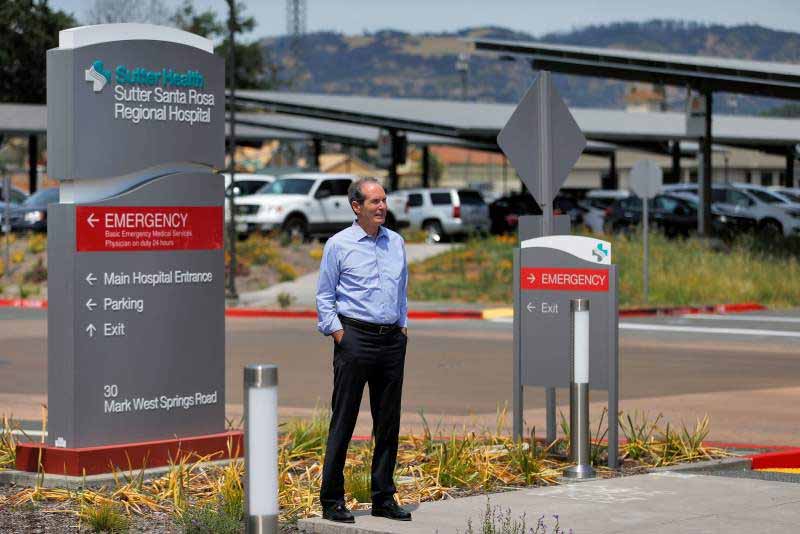At first glance, the new solar array at Sutter Santa Rosa Regional Hospital represents the latest major effort to reduce Sonoma County’s overall carbon footprint in the ongoing battle against climate change.
For Sutter Health, the solar panels are a big step toward greater energy independence and less reliance on a utility severely weakened by bigger and deadlier wildfires.
“The impetus is really sustainability and self-reliance, so that we don’t have to rely on PG&E,” hospital spokesman Shaun Ralston said. “There’s also the potential terror threat when you’re on the grid. … There’s a desire to be off the grid, because we don’t want to deal with the vulnerability.”
With the capacity to generate 2.4 million kilowatt-hours a year, Sutter’s solar array could power 500 patient rooms, or 206 homes, during that period. The solar panels are located on carports throughout the extensive parking lots that surround Sutter’s main hospital and adjacent medical office building in north Santa Rosa.
Combined with the hospital’s existing hydrogen fuel-cell generators, the panels will allow the hospital to generate on-site nearly 90 percent of its annual electricity consumption, said Wayne Bader, Sutter Health’s energy manager.
Bader said that level of electric generation is a “really big deal” for the hospital, which is among the largest energy users in the community. In its move away from PG&E’s power grid, Sutter has turned to Ameresco Inc., a company that builds, owns, operates and maintains green energy infrastructure for large customers nationwide.
At a Monday ceremony, Sutter officials will symbolically “flip the switch” on its solar panels. When it does so, the $300,000 yearly check it cuts to PG&E eventually will be sharply reduced, by an estimated more than $200,000 annually. That money will go to pay for the electricity generated by Ameresco’s solar power infrastructure.
“We’ll buy all the electricity they (solar panels) generate on our site,” Bader said. “The electricity is priced in such a way that Ameresco recoups their cost and makes a profit. Even with all that, we’re still paying less than with PG&E.”
The solar project adds to the Santa Rosa hospital’s sustainability efforts. The campus also is equipped with two 600-foot water wells and an on-site water treatment operation, as well as a 350,000-gallon water storage system under the hospital that can supply water to fire sprinklers and fire hydrants.
PG&E, California’s largest power company, said it supports Sutter’s solar move. The utility has connected more than 400,000 solar customers to its electric grid, PG&E spokesoman Deanna Contreras said.
More than 4,900 mostly residential PG&E customers have installed “behind-the-meter battery energy storage systems,” she said.
“We are seeing a smarter grid emerging as a more flexible, reliable and energy-storing system that complements and enables new technologies that our customers are using in their homes and communities,” Contreras said.
The deal between Ameresco and Sutter is not one in which the health care provider goes from one utility monopoly to another. Ameresco, based in Framingham, Massachusetts, said it’s a business partnership aimed at giving the hospital greater flexibility to use alternate energy sources, as well as enhanced resiliency from a natural disaster or other catastrophic event that compromises the traditional electrical grid.



